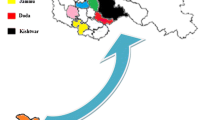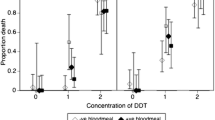Abstract
Wild-caught Xenopsylla brasiliensis from Kibwawa village, Chunya District, in south-west Tanzania were colonised in the laboratory and their offsprings used for determining the baseline susceptibility levels of the strain to DDT. A total of 120 fleas were tested with each concentration of DDT, using the techniques described by the WHO Expert Committee on Insecticides (1970).
Several filial generations were selectively raised, using DDT as a selection pressure. They were tested with various concentrations of the insecticide and their dosage-mortality regression lines compared with that of their parents.
About 5% of the parental generation (normal population) survived 1 hr exposure to 4% DDT. The LC50 of this population was 0.79% DDT. The mortality rates of the successive filial generations decreased gradually; their dosage-mortality regression lines moved to the right; and the slopes of these lines decreased. LC50s of F1, F2 and F3 were 1.6, 1.9 and 3.1% DDT, respectively. The highest DDT concentration (4%) killed 21.1 and 18.3% of F4 and F5, respectively.
It was generally concluded that DDT resistance was present in the population, and that the selection pressure (DDT) was responsible for increasing the level of this resistance in the laboratory.
Similar content being viewed by others
References
Brown A. W. A. and Pal R. (1971) Insecticide Resistance in Arthropods, 2nd edn, pp. 68–73 and 246–251. World Health Organisation, Geneva.
Busvine J. R. and Pal R. (1969) The impact of insecticide resistance on control of vectors and vector-borne disease. Bull. Wld Hlth Org. 40, 731.
Hopkins G. H. E. (1949) Report on Rats, Fleas and Plague in Uganda, p. 32. Government Printer, Entebbe.
Kilonzo B. S. (1976) A survey of rodents and their flea ectoparasites in north-eastern Tanzania. E. Afr. J. med. Res. 3, 117.
Krishnaswami A. K., Krishnamurthy B. S., Ray S. H., Sigl N. N. and Chandrahas R. K. (1963) Investigation on plague in Kolar District (Mysore State): Part II. Rats and rat-fleas. Ind. J. Malar. 17, 193.
Lund M. (1977) Report on DANIDA Consultantship Concerning Rodent Problems in Chunya District, Mbeya Region, Tanzania. An unpublished document presented to the Ministry of Agriculture, Dar es Salaam, November, 1977.
Msangi A. S. (1968) Observations on the endemicity of plague in Tanzania. Ph.D. thesis, Univ. of London.
Msangi A. S. (1975) The surveillance of rodent populations in East Africa in relation to plague endemicity. Dar es Salaam Univ. Sei. J. I, 8.
Roberts J. I. (1950) The transmission of plague in Kenya. J. trop. Med. Hyg. 53, 80.
Smith A. (1959) The susceptibility to Dieldrin of Pulex irritans and Pediculus humanus corporis in the Pare area of North-East Tanganyika. Bull. Wld Hlth Org. 21, 240.
Taylor K. D. (1976) An Outline of the Rodent Pest Problem in Tanzania. Unpublished document on a two week visit in 1976. Presented to the Ministry of Agriculture, Dar es Salaam, Tanzania, November, 1976.
WHO (1970) World Health Organisation Technical Report Series No. 443. Seventh report of the Expert Committee on Insecticides: Insecticide resistance and vector control, Geneva, pp. 100–104.
WHO (1980) World Health Organisation Technical Report Series No. 655. Expert Committee on Vector Biology and Control: Resistance of vectors of diseases to pesticides, Geneva, pp. 12 and 78.
Author information
Authors and Affiliations
Rights and permissions
About this article
Cite this article
Kilonzo, B.S. DDT Resistance in Xenopsylla brasiliensis, the Common Plague Vector in Tanzania. Int J Trop Insect Sci 6, 111–114 (1985). https://doi.org/10.1017/S1742758400002770
Received:
Revised:
Published:
Issue Date:
DOI: https://doi.org/10.1017/S1742758400002770




